The First Environmental Management Framework for Deep Sea Mining Operations Developed by CSIRO
A consortium led by Australia’s national science agency CSIRO has made a significant breakthrough in the field of deep sea mining operations. The team has developed the first-ever environmental management framework specifically designed to protect deep sea ecosystems during mining activities.
Collaborative Effort
The project, commissioned by The Metals Company Australia (TMC), brought together a team of scientists from various institutions including CSIRO, Griffith University, Museums Victoria, the University of the Sunshine Coast, and Earth Sciences New Zealand. Their collaborative efforts focused on the Clarion Clipperton Zone (CCZ) in the Pacific Ocean, a region that is being considered for potential mining of polymetallic nodules containing critical minerals such as cobalt and nickel.
Defining “Serious Harm”
One of the key outcomes of the CSIRO project is the establishment of a clear definition of “serious harm” using a traffic light system. This system categorizes impacts as green for minor, orange for moderate, and red for major, irreversible damage. The framework aims to assist regulators in determining when to modify or halt mining operations to prevent significant harm to the environment.
Operational Definitions and Monitoring
The researchers considered various factors such as seabed disturbance, sediment plumes, chemical releases, and ecosystem impacts when developing the framework. They also outlined specific criteria for determining serious harm, including irreversible effects, loss of species richness, and major ecosystem disruptions.
Additionally, the team developed an ecosystem model of the CCZ, environmental indicators for monitoring biodiversity changes, and a risk-based management process to ensure a precautionary approach to mining activities. This comprehensive approach aims to protect deep sea ecosystems while allowing for sustainable resource extraction.
Future Implications
The development of this environmental management framework marks a significant step towards responsible deep sea mining practices. By providing operational definitions and monitoring tools, the researchers hope to facilitate the establishment of limits for mining operations and promote environmental stewardship in the deep sea.
As the mining industry continues to explore deep sea resources, frameworks like the one developed by CSIRO will play a crucial role in ensuring the long-term health and sustainability of these valuable ecosystems.

